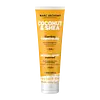What's inside
What's inside
 Key Ingredients
Key Ingredients

 Benefits
Benefits

 Concerns
Concerns

 Ingredients Side-by-side
Ingredients Side-by-side

Water
Skin ConditioningCetyl Alcohol
EmollientStearyl Alcohol
EmollientDimethicone
EmollientCocos Nucifera Oil
MaskingCetyl Esters
EmollientButyrospermum Parkii Butter
Skin ConditioningBiotin
AntiseborrhoeicTocopheryl Acetate
AntioxidantPanthenol
Skin ConditioningHydrolyzed Keratin
HumectantBambusa Vulgaris Shoot Extract
AntioxidantVitis Vinifera Seed Oil
EmollientArginine
MaskingAspartic Acid
MaskingThreonine
Proline
Skin ConditioningSerine
MaskingPhenylalanine
MaskingIsoleucine
Skin ConditioningValine
MaskingPCA
HumectantHistidine
HumectantAlanine
MaskingGlycine
BufferingCitric Acid
BufferingPropylene Glycol
HumectantCetrimonium Chloride
AntimicrobialBehentrimonium Chloride
PreservativeSodium PCA
HumectantTrideceth-12
EmulsifyingButylene Glycol
HumectantDisodium EDTA
Amodimethicone
Dehydroacetic Acid
PreservativeSodium Lactate
BufferingIsopropyl Alcohol
SolventCyclopentasiloxane
EmollientCyclohexasiloxane
EmollientPhenoxyethanol
PreservativeBenzoic Acid
MaskingSodium Hydroxide
BufferingCaramel
Cosmetic ColorantParfum
MaskingWater, Cetyl Alcohol, Stearyl Alcohol, Dimethicone, Cocos Nucifera Oil, Cetyl Esters, Butyrospermum Parkii Butter, Biotin, Tocopheryl Acetate, Panthenol, Hydrolyzed Keratin, Bambusa Vulgaris Shoot Extract, Vitis Vinifera Seed Oil, Arginine, Aspartic Acid, Threonine, Proline, Serine, Phenylalanine, Isoleucine, Valine, PCA, Histidine, Alanine, Glycine, Citric Acid, Propylene Glycol, Cetrimonium Chloride, Behentrimonium Chloride, Sodium PCA, Trideceth-12, Butylene Glycol, Disodium EDTA, Amodimethicone, Dehydroacetic Acid, Sodium Lactate, Isopropyl Alcohol, Cyclopentasiloxane, Cyclohexasiloxane, Phenoxyethanol, Benzoic Acid, Sodium Hydroxide, Caramel, Parfum
Water
Skin ConditioningHydrogen Peroxide
AntimicrobialPolysorbate 20
EmulsifyingDisodium Phosphate
BufferingPhosphoric Acid
BufferingParfum
MaskingVp/Va Copolymer
Polyquaternium-47
Skin ConditioningPolyquaternium-55
Propylene Glycol
HumectantCI 60725
Cosmetic ColorantVitis Vinifera
MaskingChamomilla Recutita Meristem Cell Culture
Skin ConditioningCitrus Medica Limonum Peel
Skin ConditioningHelianthus Annuus Seedcake
AbrasiveGlycerin
HumectantAlcohol
AntimicrobialTocopherol
AntioxidantPEG-40 Hydrogenated Castor Oil
EmulsifyingWater, Hydrogen Peroxide, Polysorbate 20, Disodium Phosphate, Phosphoric Acid, Parfum, Vp/Va Copolymer, Polyquaternium-47, Polyquaternium-55, Propylene Glycol, CI 60725, Vitis Vinifera, Chamomilla Recutita Meristem Cell Culture, Citrus Medica Limonum Peel, Helianthus Annuus Seedcake, Glycerin, Alcohol, Tocopherol, PEG-40 Hydrogenated Castor Oil
Ingredients Explained
These ingredients are found in both products.
Ingredients higher up in an ingredient list are typically present in a larger amount.
Parfum is a catch-all term for an ingredient or more that is used to give a scent to products.
Also called "fragrance", this ingredient can be a blend of hundreds of chemicals or plant oils. This means every product with "fragrance" or "parfum" in the ingredients list is a different mixture.
For instance, Habanolide is a proprietary trade name for a specific aroma chemical. When used as a fragrance ingredient in cosmetics, most aroma chemicals fall under the broad labeling category of “FRAGRANCE” or “PARFUM” according to EU and US regulations.
The term 'parfum' or 'fragrance' is not regulated in many countries. In many cases, it is up to the brand to define this term.
For instance, many brands choose to label themselves as "fragrance-free" because they are not using synthetic fragrances. However, their products may still contain ingredients such as essential oils that are considered a fragrance by INCI standards.
One example is Calendula flower extract. Calendula is an essential oil that still imparts a scent or 'fragrance'.
Depending on the blend, the ingredients in the mixture can cause allergies and sensitivities on the skin. Some ingredients that are known EU allergens include linalool and citronellol.
Parfum can also be used to mask or cover an unpleasant scent.
The bottom line is: not all fragrances/parfum/ingredients are created equally. If you are worried about fragrances, we recommend taking a closer look at an ingredient. And of course, we always recommend speaking with a professional.
Learn more about ParfumPropylene Glycol is an odorless, colorless liquid. As a humectant, it helps skin retain moisture. It also aids in delivering active ingredients.
Another role of this ingredient is preventing a product from melting or freezing. Propylene glycol also adds antimicrobrial properties to a product, elongating product lifespan.
This ingredient is considered an organic alcohol and commonly added into both cosmetics and foods.
Those with sensitive skin or conditions may develop a rash when using this ingredient.
Learn more about Propylene GlycolWater. It's the most common cosmetic ingredient of all. You'll usually see it at the top of ingredient lists, meaning that it makes up the largest part of the product.
So why is it so popular? Water most often acts as a solvent - this means that it helps dissolve other ingredients into the formulation.
You'll also recognize water as that liquid we all need to stay alive. If you see this, drink a glass of water. Stay hydrated!
Learn more about Water